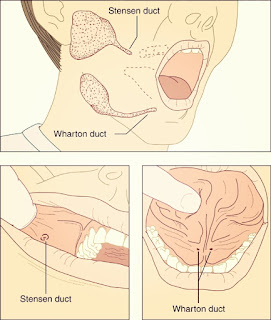Salivary Glands
Salivary glands are usually three pairs in Human Beings. The number of Salivary glands in Rabbit is four.
The major function of Salivary gland is to secrete saliva.
The main three salivary glands of Human beings are.
- Parotid Gland
- Sub Lingual Glands
- Sub Mandibular (Sub Maxillary) Glands.
Each of them are now explained in details.
Parotid Glands
- They are the largest salivary gland in human beings.
- They are situated near our ears.
- The duct of Parotid Gland is called Stensen's Duct which opens near the second upper molar teeth.
- These glands secretes Alpha-amylase (ptyalin). which help in digestion of starch (breaks starch into Maltose and Dextrin).
Sub Lingual Glands
- They are the small sized salivary glands
- They are situated at the ventral portion (base) of tongue.
- The duct of Sub Lingual gland is called Duct Of Rivinus.
Sub-Mandibular Gland
- They are also called Sub-maxillary or Wharton's Gland.
- They provide the largest contribution to the volume of saliva (70%)
- They are situated at angles of lower jaw.
- The duct of Sub Mandibular Gland is called Wharton's Duct.
Salivary Glands Functions
Functions of salivary Glands
- It helps in lubrication and binding of masticated food into bolus.
- Saliva contains lysozymesand thiocyanates which kill the bacteria.
- It provides alkaline buffering.
Saliva
It contains 99.5% water, IgA, mucous, mucin, ptyalin, lysozyme, thiocyanates, urea, uric acid, HCO3, Na+, K+ Cl- etc.
Saliva are slightly acidic in Carnivores and alkaline in Ruminants .
Nice to know
- Infra orbital is the Rabbits but they are absent in humans.
- Parotid salivary gland is modified into labial poisonous glands in most snakes.
- Salivary glands are absent in frog, toad, sea cow and whale.
If you liked this article on Salivary glands, Please share this content with your friends so more individual could get benefit.






